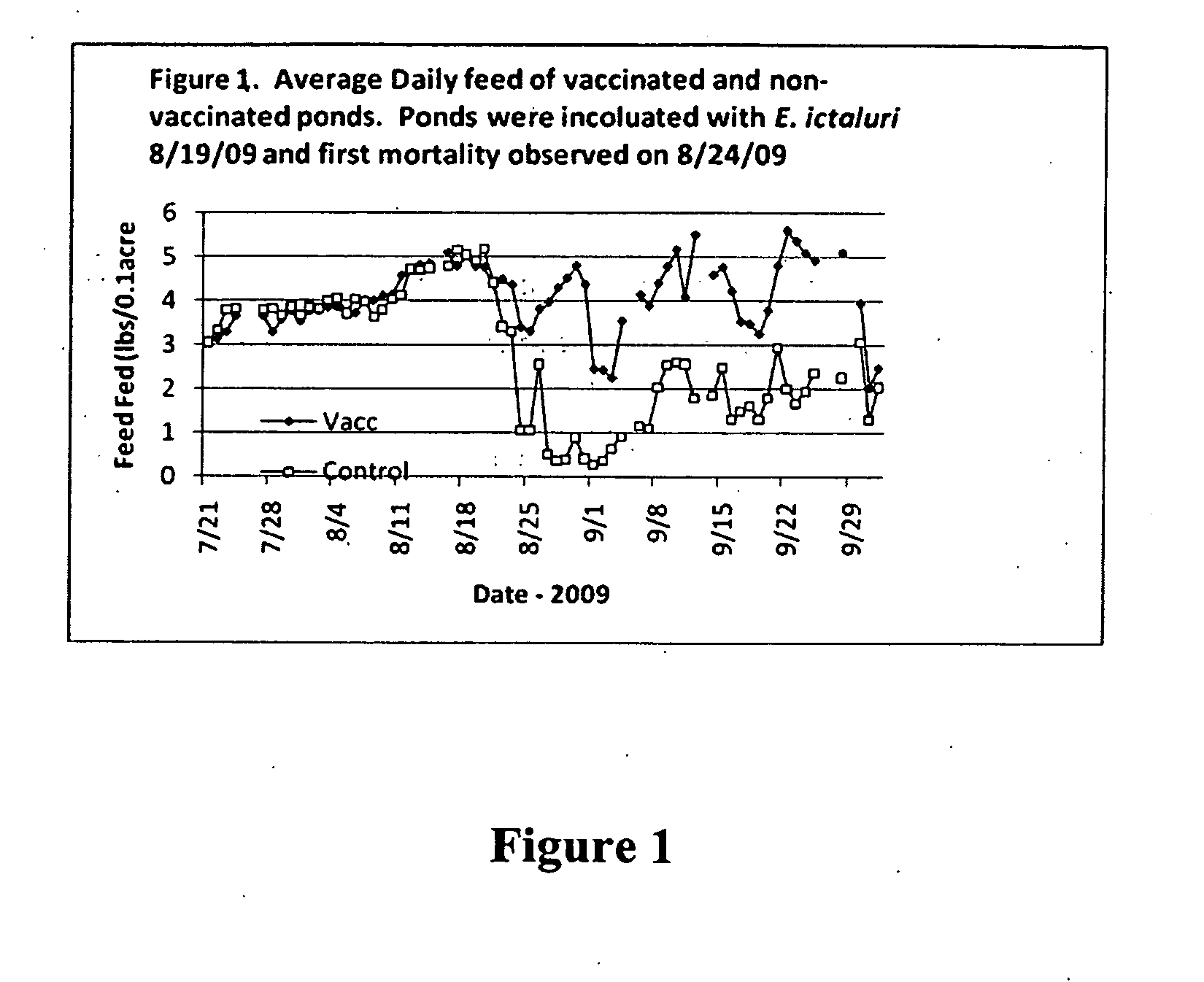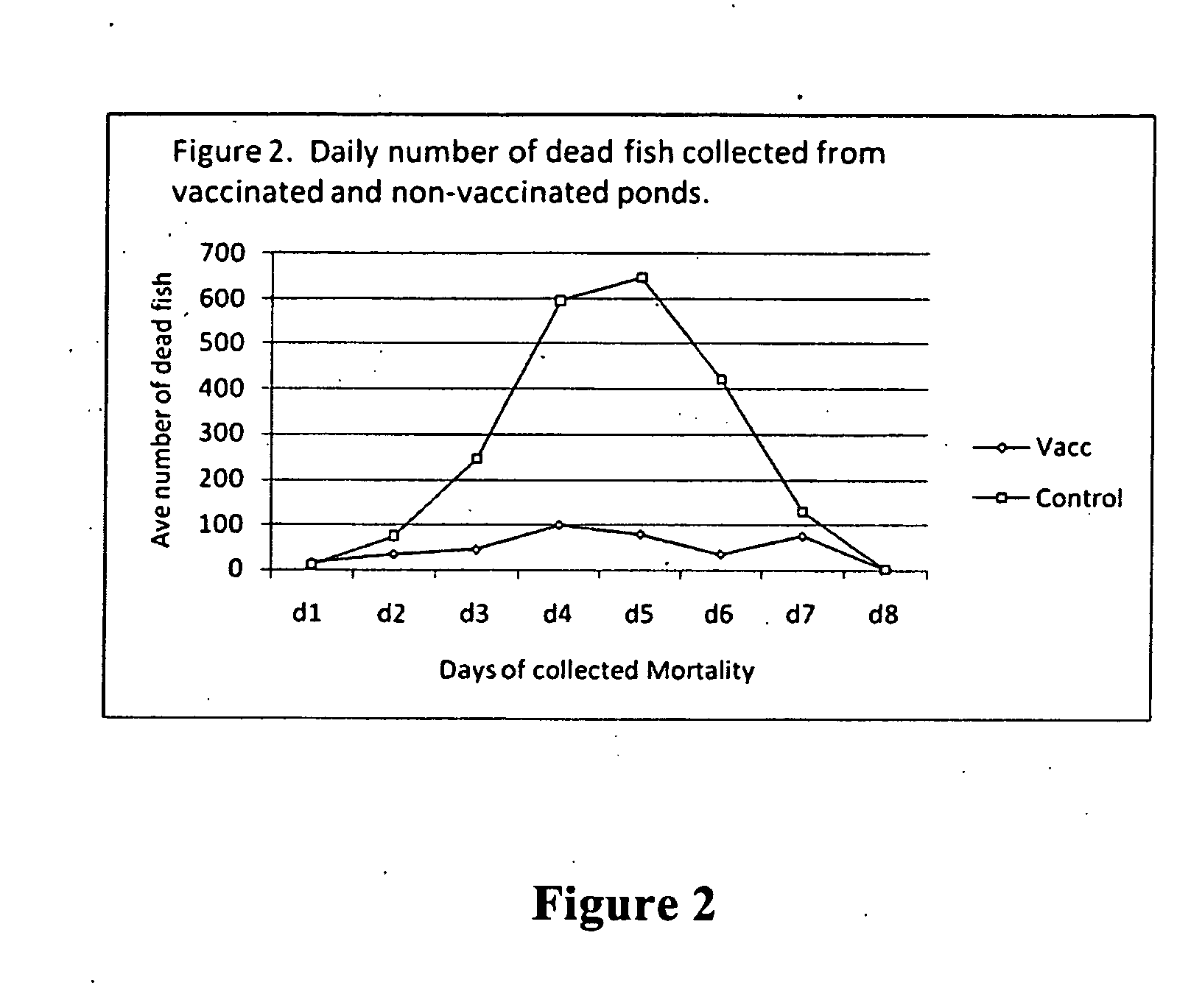Oral vaccination of fish with live attenuated edwardsiella ictaluri vaccines
a technology of edwardsiella ictaluri and live attenuated edwardsiella, which is applied in the field of vaccination of fish, can solve problems such as unfavorable scenarios, and achieve the effect of efficient and effective delivery of the vaccine to the fish
- Summary
- Abstract
- Description
- Claims
- Application Information
AI Technical Summary
Benefits of technology
Problems solved by technology
Method used
Image
Examples
experiment 1
[0041] Demonstration of an Oral Delivery Platform Using a Live Attenuated E. ictaluri Isolate Incorporated in Feed.
[0042]Demonstration of concept: Oral delivery of an attenuated strain of E. ictaluri is effective in inducing protective immunity in channel catfish against enteric septicemia of catfish (ESC).
[0043]Methods
[0044]Experimental Treatments: Optimal oral doses were evaluated in channel catfish fingerlings 3-4 inches in length. Vaccination trials were conducted in 30 gallon aquaria containing approximately 22 L of oxygenated well water. Water temperature ranged between 26-27° C. Thirty (30) aquaria were each stocked with 20 channel catfish and assigned one of 5 treatments (6 replicates per treatment). Treatments consisted of fish fed a commercial catfish feed mixed with a non-diluted vaccine (1:0) and a 1:10, 1:50, and 1:100 dilution of the vaccine. The remaining 6 aquaria received feed only on the day of vaccination and served as non-vaccinated controls.
[0045]Feed Preparatio...
experiment 2
[0050] Comparison of Immersion and Oral Vaccination Applicable to Current Industry Practices.
[0051]Objective: To evaluate the effectiveness of a novel oral vaccination strategy compared to immersion vaccination practices in current use by the channel catfish industry.
[0052]Methods
[0053]Experimental Treatments: Channel catfish, obtained from a single population, were vaccinated as fry by immersion exposure or as fingerlings by oral delivery. Channel catfish sac-fry (1-3 days of age post-hatch) were obtained from a commercial catfish hatchery and placed in a single rearing trough. At the swim-up stage of development, fry were fed hourly a commercial trout starter diet. Fry were vaccinated 10-12 days of age post-hatch (in accordance to label directives and current industry practices) by immersion exposure with a commercially-available live attenuated ESC vaccine (AQUAVAC-ESC™). Twelve (12) separate groups of fry (1000 fish) were vaccinated and each group placed in 12, 100 L aquaria con...
experiment 3
[0058] Evaluation of Newly Attenuated Isolates of E. ictaluri (S97-773-340 X, Y, P) as Potential Candidates for Vaccine Development.
[0059]Objective: To evaluate the effectiveness of newly attenuated strains of Edwardsiella ictaluri in an oral delivery platform.
[0060]Methods
[0061]Attenuation process: A virulent isolate of Edwardsiella ictaluri (S97-773), collected from a natural ESC outbreak on a commercial fingerling farm in northwest Mississippi, was attenuated by successive passage on bacterial media containing increasing concentrations of rifamycin (Rif) according to modified procedures described by Schurig, et al. (1991). Multiple colonies were transferred with each passage. An isolate exhibiting growth on media containing incremental increases of Rif greater than 40 μg / ml was designated with a letter to identify potentially unique isolates. Isolates were successively transferred until growth was exhibited in the presence of 340 μg Rif / ml. Multiple isolates were transferred to B...
PUM
| Property | Measurement | Unit |
|---|---|---|
| length | aaaaa | aaaaa |
| temperature | aaaaa | aaaaa |
| time | aaaaa | aaaaa |
Abstract
Description
Claims
Application Information
 Login to View More
Login to View More - R&D
- Intellectual Property
- Life Sciences
- Materials
- Tech Scout
- Unparalleled Data Quality
- Higher Quality Content
- 60% Fewer Hallucinations
Browse by: Latest US Patents, China's latest patents, Technical Efficacy Thesaurus, Application Domain, Technology Topic, Popular Technical Reports.
© 2025 PatSnap. All rights reserved.Legal|Privacy policy|Modern Slavery Act Transparency Statement|Sitemap|About US| Contact US: help@patsnap.com



